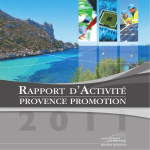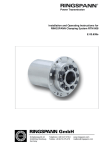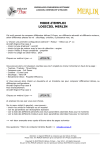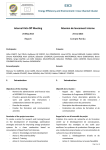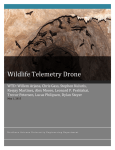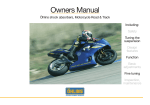Download carbon propellers helices e-props ng
Transcript
CARBON PROPELLERS HELICES E-PROPS NG-D RANGE ASSEMBLY & OPERATING INSTRUCTIONS ref 2013-02-10E HELICES E-PROPS - RANGE NG-D light carbon propellers - disassembled - ground adjustable Blades in carbon, carbon braid, with continue fibers between upper and lower surfaces of the blade, epoxy resin, honeycomb core with internal spar, blade's foot with stainless steel ring, RTM (Resin Transfer Molding) manufacturing Hub in beech wood veneers impregnated with special resins, round or rectangular shape depending on drill hole pattern, manufacturing of the hub on 3 axis machining center Specific E-PROPS design Propeller's pitch is adjusted at workshop for each engine. Pilot can also adjust the pitch himself Traceability: ref# + serial# on each blade, ref# on each hub Advantages of a NG-D propeller : VERY LIGHT - about 750 gr for a 125 cm diameter - more resistant propeller => faster acceleration and deceleration of the engine (the propeller is more reactive, it stops much more fast, that is 2 x fewer risks of break in case of shock in the propeller), 2 x less stored kinetic energy, thus 2 x fewer damages in case of impact. - Comfort increased for the pilot => 2 x less mass propeller on the back, 2 x fewer gyroscopic efforts, less couple - Better functioning of the engine => 2 x fewer constraints on the reducer, fewer vibrations due to the functioning propeller DISASSEMBLED - in 3 parts : 2 blades and 1 hub - easy to assemble and disassemble, interesting for storage and transport - simple replacement of one blade GROUND ADJUSTABLE PITCH - Pitch adjusted in worshop for each engine - reducer couple by keyways, with possibility for the customer to change the pitch if necessary NG-D PROPELLER'S ASSEMBLY 1- Check the engine First verify in "engine" and "paramotor" manuals the appropriate instructions for propeller's implementation. Then check the good state and the cleanliness of the threadings receiving screws in flange's engine. Screws have to screw completely by hand. 2- Assembly of the blades [a] Get both blades, both parts of the hub and screws together. The material of the hub is very dense and does not require any plate. Medium washers are included in the kit to put under the screws' heads. [b] Locate the keyways in the blades'feet and in the hub [c] Put the blades in the hub [d] Close the hub and torque the screws [a] [b] [c] [d] WARNING Propeller is a vital part of the aircraft. A problem with the propeller can force to an emergency landing and may possibly cause vibrations such as the such as the aircraft or its engine could be damaged. The propeller has to be assembled and correctly maintained according to the instructions of the present document. E-PROPS PROPELLERS ARE NOT CERTIFIED PROPELLERS. THEIR USE IS ONLY UNDER THE CUSTOMER'S RESPONSIBILITY Hélices E-PROPS A department of the ELECTRAVIA company Aérodrome de Sisteron 04200 Vaumeilh – France +33 4 92 34 00 00 - Email: [email protected] www.e-props.fr 3- Implementation on the engine Put the hub against the flange of the engine and make sure that both faces are flat. The arrow on the side of the hub is pointed towards the engine. When positioned behind the paramotor, the pilot must see the lower surface of the blades with the E-PROPS stickers. Warning: the propeller must be mounted directly against the flange. NEVER INSERT a rubber ring or metallic plate between the propeller and the flange : the screws could break. 4- Screws tightening, locking, torque Tightening of the screws as follow : 1 – 3 – 2 – 4. TORQUE => Screws 6 mm : 1,4 daN.m Screws 8 mm : 2 daN.m The nominal torque of tightening of screws will be applied in three successive operations and in a progressive way. The torque of tightening of every operation will be equal in 1/3 of the nominal value. During the tightening, a light collapse of the material is normal on the flange and on the hub. The torque of tightening must be necessarily controlled after the first hour of flight, and afterward, as often as necessity, and at least every 25 hours. Warning: if the screws are not supplied by Hélices E-PROPS, they have to be of quality 8.8. A superior quality is not good. OPERATION / MAINTENANCE / REPAIR Any running propeller can present a potential danger for the pilot, the passenger and/or the spectators. Never let the children touch propellers, even when the engine is stopped. Be always extremely careful as soon as an engine equipped with a propeller may turn. Warning: before turning the propeller with the hand, always verifying attentively that the driving ignition is off. NG-D propellers => max 3000 RPM Max power : 35 hp on engines with a reduction gear The cleaning of a carbon propeller is made with a sponge, with some water with soap, or with a product for windows cleaning. Maintenance before each flight: visual inspection of the propeller and check of the screws Periodic maintenance: check of the tightening every 25 hours of flight or every 3 months If an incident or a shock require an important repair, this one must be realized by Hélices E-PROPS in its workshops, or by a specialist after discussions with the team E-PROPS. Blades have a ref# and a serial#, hub has a ref#: Blades # Hub ref # These references are important for determining with the team E-PROPS the modifications or the possible replacements of elements. They also are indicated on the invoice. The final checks of the propeller, and in particular balancing, are made by Hélices E-PROPS before the delivery. Any modification of the propeller can damage the balancing and generate vibrations which could damage the engine. In case of incident, please contact Hélices E-PROPS as soon as possible.



